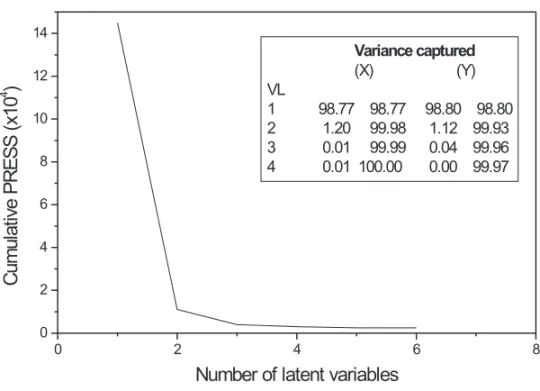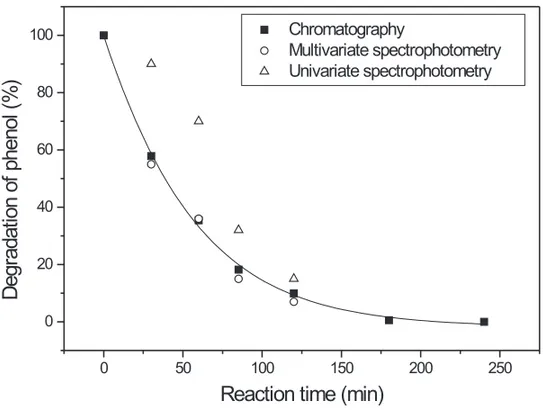congeners by multivariated calibration
KELY VIVIANE DE SOUZA and PATRICIO PERALTA-ZAMORA
Laboratório de Química Ambiental e de Materiais, Departamento de Química-UFPR CP 19081, 81531-990, Curitiba-PR
Manuscript received on December 15, 2000; accepted for publication on August 9, 2001; presented byFERN AN DOGAL E MBECK
ABSTRACT
The generation of poly-hydroxilated transient species during the photochemical treatment of phenol usually impedes the spectrophotmetric monitoring of its degradation process. Frequently, the appearance of com-pounds such as pyrocatechol, hydroquinone and benzoquinone produces serious spectral interference, which hinder the use of the classical univariate calibration process. In this work, the use of multivariate calibration is proposed to permit the spectrophotometric determination of phenol in the presence of these intermediates. Using 20 synthetic mixtures containing phenol and the interferents, a calibration model was developed by using a partial least square regression process (PLSR) and processing the absorbance signal between 180 and 300 nm. The model was validated by using 3 synthetic mixtures. In this operation, typical errors lower than 3% were observed. Close correlation between the results obtained by liquid chromatography and the proposed method was also observed.
Key words:Phenol, spectrophotometric determination, multivariated calibration.
1 INTRODUCTION
Multivariate calibration processes are very useful in analytical chemistry, mainly in the analysis of sam-ples composed by several components that need in-dividual determination from instrumental data with low selectivity (Miller 1995).
In view of characteristic such us: high sensi-bility, operational facility and low cost, the UV-VIS spectrophotometry could be one of the most useful analytical tools. Unfortunately, its chronic prob-lems related to low selectivity usually impede the determination of analyses from complex matrixes.
The spectrophotometric determination of phe-nol in the presence of congeners is a very complex
Correspondence to: Patricio Peralta-Zamora E-mail: zamora@quimica.ufpr.br
Fax: 41.3613186
problem in analytical chemistry due to the spectral interferences, which results in widely overlapped absorption bands. For this determination, the con-ventional univariate calibration method is impracti-cable, because of the contribution of one specie on the absorption signals of others, and vice versa.
520 KELY VIVIANE DE SOUZA and PATRICIO PERALTA-ZAMORA
al. 1997).
This paper describes an analytical methodol-ogy for determination of phenol in the presence of typical products of its photochemical degradation by using a spectrophotometric method and a multivari-ate calibration technique (Partial Least-Squares Re-gression, PLSR). Multivariate calibration consists of the establishment of an association between ma-trixes of chemical data (Peralta-Zamora et al. 1997, 1998). The process is composed of two steps: cali-bration and prediction. In this case, the calicali-bration step consists of the development of a mathematical model which can reproduce a concentration matrix
Y (contains‘‘n’’ lines which correspond to sam-ples and‘‘q’’columns of different phenol concen-trations) from a matrixX(with‘‘n’’lines of samples and‘‘p’’columns of selected wavelength values).
2 EXPERIMENTAL
2.1 RE ACTAN T S A N DSTAN DA RDSO L U T ION S
Phenol, pyrocatechol, hydroquinone and benzo-quinone were of analytical grade. Standard solu-tions were prepared in deionized water in concen-trations of 1.0 molL-1.
2.2 IN ST RU M E N TAT IO N
Spectrophotometric measurements were made with a HP 8154 A spectrophotometer, using 1 cm quartz cells. Chromatographic determinations were car-ried in a Waters equipment, using a C18 column, a methanol:water (30:70 v/v) mobile phase and a spectrophotometric detector (252 nm).
2.3 PH OT OCH E MICALPRO CE SS
The photochemical treatment was carried out in a 150 mL glass reactor, equipped with water refrig-eration, magnetic stirrer and oxygenation system. Suspensions formed by 100 mL of phenol aqueous samples (1×10-3molL-1) and 15 mg of photocata-lyst (ZnO) were irradiated from the top with a 125 W medium pressure mercury lamp without the glass cover (fluence rate: 15 Jm-2s-1atλ >254 nm), lo-cated at a distance of 12 cm from the solution
sur-face. The system was bubbling with commercial oxygen at flows of about 10 mLmin-1, through a sintered glass placed in the bottom of the reactor. For analytical control, samples were taken at conve-nient times and filtered through a 0.45µm Millipore filter.
2.4 AN ALY T ICA LPROCE DU RE
Known amounts of the standard solutions were placed in a 10 mL volumetric flask and completed to the final volume with deionized water. The fi-nal concentration of these solutions varied between 2.5×10-7 and 2.5×10-4 molL-1 of each compound. This concentration range was selected since prelim-inary chromatographic studies showed that the con-centration of the studied species reach this concen-tration interval, when a 1×10-3 molL-1phenol so-lution is submitted to photochemical degradation at our experimental condition.
The absorption spectra were taken in the 180-300 nm range.
The Calibration was made with the conven-tional univariate method and a partial least-squares regression (PLSR), using the recorded adsorbance values between 180 and 300 nm as the dependent variables, with intervals of 2 nm. The preprocess-ing program was developed in MATLAB 4.0 and the PLSR was performed by using the PLS-toolbox 1.5.
3 RESULTS AND DISCUSSION
Fig. 1 – Typical UV-VIS spectra of phenol and congeners.
522 KELY VIVIANE DE SOUZA and PATRICIO PERALTA-ZAMORA
the model construction, a lower prediction error (PRESS) was observed (Figure 2). The great ability of the developed model to predict the concentration of the sampled used in the calibration stage can be visualized from Table I. In this stage, prevision er-rors lower than 6% were observed.
TABLE I
Predicted concentration of phenol for the cali-bration set.
Sample Added Predicted
concentration concentration (molL-1, × 104) (molL-1, × 104)
1 7.5 7.510
2 5.0 4.969
3 2.5 2.496
4 0.5 0.530
5 7.5 7.497
6 5.0 4.976
7 2.5 2.520
8 0.5 0.491
9 7.5 7.556
10 5.0 4.973
11 2.5 2.404
12 0.5 0.482
13 7.5 7.442
14 5.0 5.033
15 2.5 2.569
16 0.5 0.465
17 7.5 7.493
18 5.0 5.035
19 2.5 2.532
20 0.5 0.525
The robustness of the multivariate model was evaluated by predicting the phenol concentration in 3 different synthetic mixtures. The result (Table II) indicated that the model permits the resolution of this complex mixture, permitting prevision errors lower than 3%.
Finally, the efficiency of the multivariate cal-ibration model was appraised by monitoring the residual concentration of phenol during a
photo-TABLE II
Errors in the prediction of new samples.
Phenol concentration,
Sample molL-1 Error, %
Predicted Added
1 6.05 × 10-4 6.00 × 10-4 + 0.8 2 3.49 × 10-4 3.50 × 10-4 – 0.2 3 7.73 × 10-5 7.50 × 10-5 +3.0
chemical degradation process, and comparing these results with those obtained by application of liq-uid chromatography and classical univariate spec-trophotometry. The results (Figure 3) indicated a close correlation between the result obtained by chromatography and the proposed multivariate methodology. On the contrary, the results of the univariate calibration procedure show high positive errors, due to the presence of chemical species that absorb strongly in the monitored spectral region.
4 FINAL REMARKS
The information contained in a spectral data can be adequately expressed by using a conjunct of few principal components, which facilitates the elabo-ration of multivariate calibelabo-ration models. The use of all the information registered by the instru-ment permit overcome the serious spectral interfer-ence usually observed in UV-VIS spectrophotomet-ric methodologies, fact that increases its analytical potentiality and permit the analysis of complex sam-ples.
RESUMO
A geração de espécies transientes polihidroxiladas,
du-rante o tratamento fotoquímico de fenol, geralmente
im-pede a utilização de espectrofotometria UV-VIS no
moni-toramento do processo de degradação. Freqüentemente,
o surgimento de espécies como pirocatecol, hidroquinona
e benzoquinona produz sérios problemas de
interferên-cias espectral, os quais inviabilizam a utilização de
Fig. 3 – Photochemical degradation of phenol monitored by liquid chromatography and uni-variate and muliuni-variate spectrophotometry.
esta se propondo a utilização de processos de calibração
multivariada para viabilizar a determinação
espectrofo-tométrica de fenol na presença destes intermediários. O
modelo de calibração multivariada foi desenvolvido por
regressão de mínimos quadrados parciais (PLSR),
utili-zando-se 20 misturas sintéticas contendo fenol e
interfe-rentes e processando-se o sinal de absorbância obtido entre
180 e 300 nm. O modelo foi validado utilizando-se um
conjunto de 3 misturas sintéticas, o que levou à obtenção
de erros de previsão típicos inferiores a 3%. Uma
exce-lente correlação foi também observada entre os resultados
obtidos por cromatografia líquida e por aplicação do
pro-cedimento proposto.
Palavras-chave: Fenol, determinação
espectrofotomé-trica, calibração multivariada.
REFERENCES
Ba u t ist a RD, Aber á st u r i FJ, Jimén ez AI a n d Jimén ez F. 1996a. Simultaneous
spectrophotomet-ric determination of drugs in pharmaceutical prepa-rations using multiple linear regression and partial least-squares regression, calibration and prediction methods. Talanta, 43: 2107-2115.
Ba u t ist a RD, Jimén ez AI, Jimén ez F a n d Ar ia s JJ. 1996b. Simultaneous spectrofluorimetric deter-mination of europium, dysprosium, gadolinium and terbium using chemometric methods. Talanta, 43: 421-429.
Ber z a s Neva do JJ, Rodr ígu ez Fl or es J a n d Ca s-t a ñ eda Peñ a l vo G. 1997. Simuls-taneous spec-trophotometric determination of ethinylestradiol and levonorgestrel by partial least squares and principal component regression multivariate calibration. Anal Chim Acta, 340: 257-265.
Mil l er CE. 1995. The use of chemometric techniques in process analytical method development and op-eration. Chemometrics and Intelligent Laboratory Systems, 30: 11-22.
524 KELY VIVIANE DE SOUZA and PATRICIO PERALTA-ZAMORA
N a n d Poppi RJ. 1997. Chemometric alternatives for resolution of classical analytical problems. Spec-trophotometric determination of lanthanide mixtures. Talanta, 44: 1815-1822.


